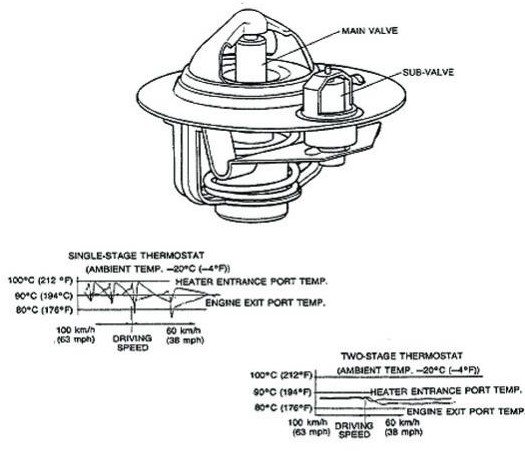| We will
now return to the E-Type Series 1 3.8, but most of these comments also
apply to XK 150 and the various Marks.
The best British thermostat in 1960 was the Smith sleeved bellows style, although it was already an anachronism. As we have seen, bellows thermostats constrain cooling system design because they are intolerant of high ambient pressure, and the resulting 3.8 cooling system reflects these limitations. Let's take a closer look.
Water
exits the 3.8 engine block through the intake manifolds, then up through
a separate water rail. The thermostat housing sits at the front of the
water rail, at right angles to the primary flow path. While the engine
is cool, bypass flow exits the thermostat housing through a slot cut into
the side of the passage, and then out through the front of the rail. When
the bellows expands, the control sleeve moves forward with the poppet,
and will cover the bypass slot, while opening the main passage to the radiator
:
By forcing
the main flow into a right angle turn at the base of the thermostat, dynamic
pressure is less likely to lift the poppet. But blunting the flow at this
point raises static pressure locally, which affects the expansion of the
bellows. For this reason, a 4 lb pressure cap is the maximum that can be
used. This is a fundamental compromise to the efficiency of the cooling
system.
So what thermostat can be used with this system today? Here are some options: 1) The original Smith's thermostat is 85025 is the easy choice, if you can locate an example. In most cases, the summer temperature range, 74 or 75C is the best choice. As the supply of these is gradually exhausted, there are reasonably good repros of the Smith style bellows thermostat available from Moss (PN 434-156) or Rimmer Brothers (pn 107590). The only available temperature range for these is 74C. The approximate flow cross section for all bellows thermostats is .75 sq", which is relatively restrictive. The sleeve diameter on an original Smiths is 48.3mm, the Moss sleeve is 48.1mm. Because maximum system pressure is 4lbs with a bellows thermostat, you must always use a 50/50 or stronger solution of antifreeze to get adequate boiling point elevation. Boiling Point Elevation vs Pressure
Bellows thermostats limit the design because they are sensitive to pressure. Since a wax motor thermostat allows for higher pressures, and thereby extends boilover protection, let's look at some options that will allow you to use a higher rated cap. 2) Best
alternative solution. If you are very lucky, you may be able to find Jaguar
pn c20766 or c20766/1 (175F or 182F). This was the original wax thermostat
designed as a retrofit for Smiths 85025. Flow cross section is exactly
1 sq inch. Since it has a wax motor, the pressure rating of the cap can
be increased to elevate boiling point. This thermostat was specified as
a drop-in retrofit for the 3.8 E-Type. It was factory installed after 1962
on all S1 3.8's and 4.2's. Sleeve diameter flares from cap to leading edge,
and is 48.4mm at the leading edge. Perfect. Factory. Unobtainable. I have
no idea why Jaguar would have let this go out of production, as it's applicable
to all sleeve-bypass applications. This thermostat must have disappeared
fairly early after the introduction of the 4.2 engines, as not one of the
cars and scrap manifolds I've examined still has one. All of them had single-poppet
thermostats (see below), with no bypass provision whatsoever.
3) Alternative: Several vendors supply a thermostat, C3731/1. This is a cut down Land Rover Series IIa thermostat (see below), which mimics the reverse action of c20766. It fits without modification. The flow cross section of 3731/1 as well as the source Land Rover thermostats is .94 sq in. Unfortunately, when the Land Rover's tapered bypass shutter is cut down, it ends up being just over 47mm diameter, leaving a gap of 1.25mm at the bypass. Adding to this, the part seems to have gone through some evolution and so the spec is inconsistent from example to example. Opening temperature is 74c. 4) Alternative: unmodified Land Rover Series IIa thermostat. The original LR thermostat is a cousin to Jaguar c20766. The diameter of the full bypass shutter is 48.5mm., however, on the widely available Chinese copies, the shutter is often just 47.5mm. Unfortunately, the LR thermostat will not fit in a 3.8 housing unless the car's thermostat neck is modified. It needs to be bored out to 54 mm for a depth of 9mm. Once the neck is machined, it will ONLY accommodate a Land Rover thermostat, so it's a permanent commitment. Here
is a photo comparison of Jaguar C20766, the Land Rover SIIa thermostat
and c3171/1, open and closed. Note the conic section sleeves on the original
Western Thomson thermostats. When the sleeve is cut down for 3171/1, the
diameter is reduced:
5) Workable
solution. Use a non-bypass wax thermostat. At some point, Jaguar superseded
C20766 with C27650, which is a 74C, single poppet thermostat. Flow section
of the original part is .81. This thermostat is still available under this
part number, but the specific design has changed over time. Although the
thermostat will not control the bypass passage, most of the flow will still
pass through the main poppet. This would be similar to the open bypass
application described in Chapter 3. Unfortunately, the right angle turn
made by flow at the thermostat housing will encourage bypass flow.
6) A
possible improvement when using a single poppet thermostat would be to
completely block the bypass using a brass stopper in the hose, and then
drill a 3/8" hole in the flange, or use Stewart Components model 300 or
301, which are Robertshaws which have been punctured to allow some bypass
flow through the radiator. (Warning: there have been reports of freeze
plugs popping if the holes in the thermostat aren't large enough.) A modest
leak in the thermostat would cause somewhat longer warm ups, but nobody
is driving these cars in the winter. The Robertshaw thermostat is a high
flowing thermostat in its native application, and even with the constraint
of the 49.6mm thermostat housing in a Jag, it will have an effective flow
cross section of 1.09 sq in.
7) Finally, a decent modern solution that's gone NLA. Several vendors once offered a modified Robertshaw thermostat for this application. Because the sleeve of the Robertshaw is just 40mm, a secondary 49mm sleeve was soldered to the thermostat using brass tabs. This further constrained the flow path to about .75 sq in, which is comparable to the original Smiths. The set point was either 71C or 76C, depending on the choice of donor thermostat. The wide sleeve did a good job of blocking the bypass when open. Unfortunately, not in current production.
Things to know. - Fail safe thermostats. Not appropriate for this application. This design has a spring loaded clip that locks the thermostat open if the temperature exceeds some predefined limit, usually 230F. The theory is that at these elevated temperatures, the thermostat will fail and collapse, permanently closed. But locking it open has no value. If you reach these temperatures, you will know it, and you should replace the thermostat as a matter of good practice. The wax motor will only fail if the temperature exceeds the melting point of the rubber seal, which won't happen unless the fluid is completely boiled out. At that point, it may or may not collapse. More likely it would stick at some mid point. While nominal risk is small, the true risk with fail safe designs is that the thermostat may lock without you knowing, in which case the thermostat would be inoperative and warm up will be extended. And none of the available fail-safes have bypass control sleeves. - SuperStat.
SuperStat is a trademark of Stant. Buyer beware: there are no SuperStats
that have a bypass sleeve for S1 E-Types. The label appears on Stant or
Gates thermostats with a weir valve design, and cannot be properly attached
to any other product. A weir valve is a short cylinder welded or pressed
into the flat poppet. The cylinder has a series of deep V-shaped notches.
The idea is that instead of exposing flow along the entire periphery of
the poppet, coolant will initially only flow through the apex of the V
notches. This gives more precise, gradual control at start-of-open, and
so tighter thermal regulation. Only when the thermostat has opened a good
part of the way will the periphery open up to maximize flow, giving a non
linear response to rising temperature.
<Bypass
Systems Main
S1 E-Type 4.2>
Copyright©2019
CoolCat Express Corp
|
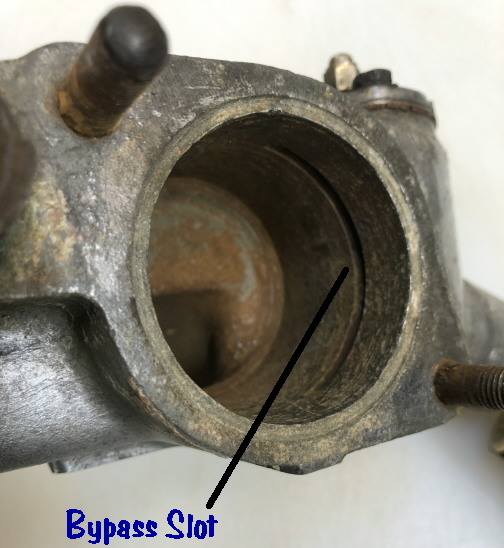
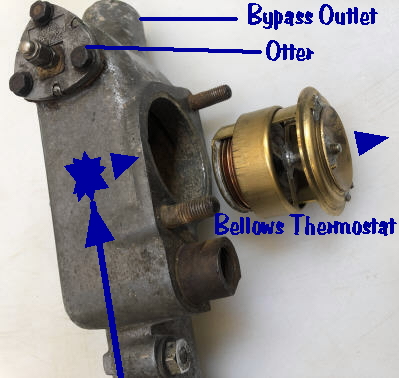
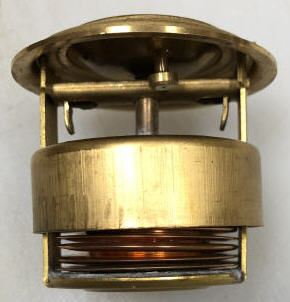
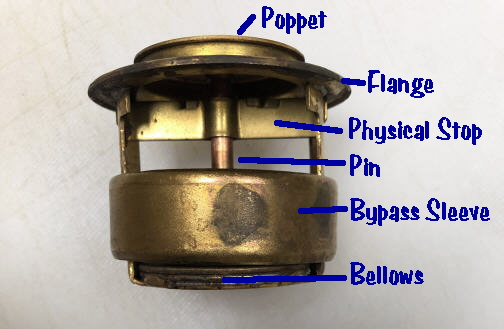
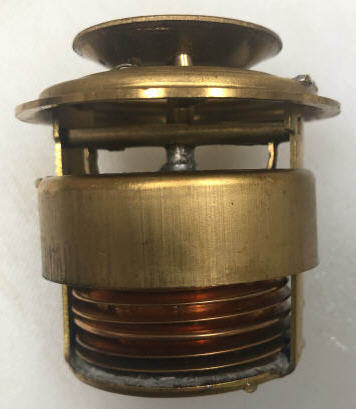
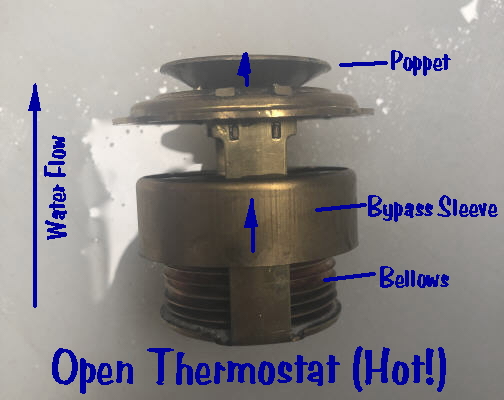
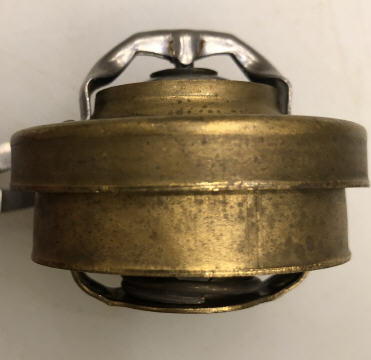
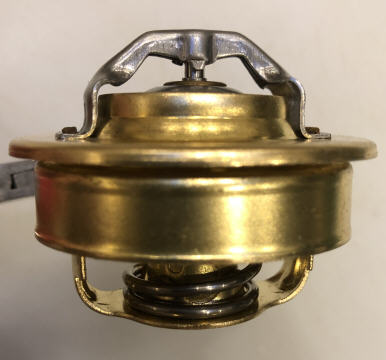
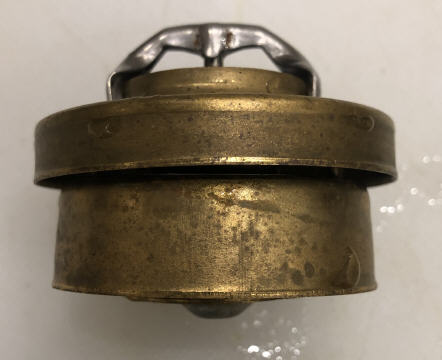
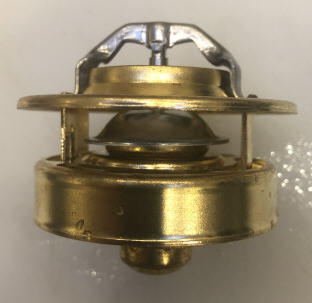
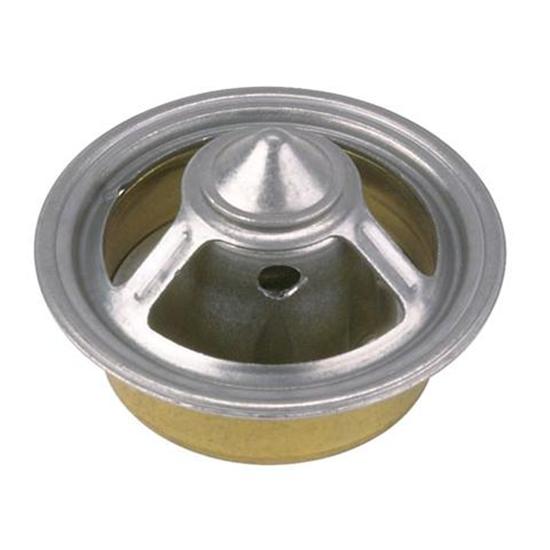

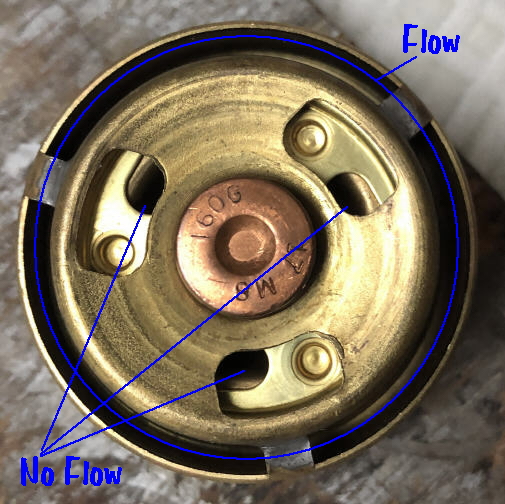 `
`
